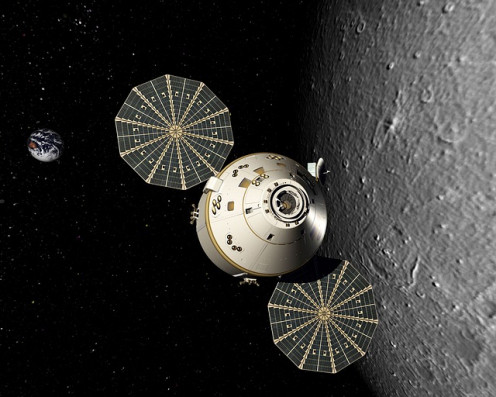Space Travel Achievements: Solar Sails Fly by Sun Power
The Sunjammer Solar Sail To Launch in 2017

Arthur C. Clarke's Sunjammer Becomes a Reality On Its 50th Anniversary
Sir Arthur C. Clarke originated the workable idea and mechanics of communication satellites (ComSats) that we cannot live without today. When he came up with the idea, other scientists criticized him and told him it would never work. People laughed at him, but no one is laughing now.
He also wrote about a practical solar sail in 1963.
A planned 2017 launch of Sunjammer by NASA was cancelled, but the Planetary Society launched its privately funded solar sail via LightSail, a craft taken into low Earth orbit along with a U.S. Air Force X-37B robot space plane in May 2015. Japan launched a solar sail back in 2010.

Science Fiction and Science Speculation About Solar Sails
Scientist Johannes Kepler, in a letter to Galileo in 1610 expressed his desire to see deployment of a technology that can harness sunlight in order to propel spaceships.
Jules Verne likely made the first mention in literature of such a creation in his From the Earth to the Moon (1865, at the close of the American Civil War). A few other references were made in science fiction from the 1880s through WWI. However, the amazing Cordwainer Bird wrote convincingly about light sails in 1960s story, The Lady Who Sailed the Soul.
Others mentioned "solar pressure" and "light pressure" but in my opinion, Sir Arthur C. Clarke was the first to make the notion of a workable solar sail sound feasible - in a solar-yacht race that was abandoned because of an intense solar flare that threatened the lives of the sailors. His story is believable - so much so, that NASA named its solar sail after it.

I first took notice of a solar sail in the 1986 film Star Trek: The Voyage Home. It has always reminded me of the usefulness of the solar sail since that time.
In 1963, Sir Arthur wrote the short story Sunjammer, also known as The Wind From the Sun.
Fifty years later in 2013, the world's largest solar sail was called Sunjammer, under the operation of NASA and its Commercial Crew. Arthur C. Clarke was mentioned very little in news (Fox News gave him a headline) about its naming or its impending launch date in early 2015. One would need to have heard of or read his short story in order to recognize the naming connection.
Solar Sails Technology In the 1970s
NASA began studying various types of solar sail design, construction, and operation in its Jet Propulsion Labs at California Institute of Technology during the 1970s. This occurred after Clarke's short story have been on the market fr nearly a decade.
It would be a good idea to read all of Clarke's work to see what science will come up with next.
A solar sail can serve as a propulsion device, powering movement by using solar radiation (solar wind). It can also serve as a high-gain antenna.
Solar sails are made of super-thin materials, like Mylar, 2 µm-thick Kapton (made by DuPont), and very thin aluminum. Alumina (aluminum oxide) and carbon-fiber sails may be best for certain purposes. A 20-nm-thick film of lithium might be useful and could be manufactured in space. Other metals were under investigation in 2013.
NOTE: I had a handkerchief-sized piece of Mylar when I was 10. Told that it was impervious and could not be torn, I promptly ripped a hole through it. Mylar may not be our best material for solar sales.
Types of Solar Sails

Japanese and American Solar Sails
Japan's JAXA space agency tested a solar sail in July 2010, having named it IKAROS: Interplanetary Kite-craft Accelerated by Radiation Of the Sun, although it sounds like the legendary Icarus, who flew too close to Sol.
Japan was first to show that the solar sail could be a successful functioning primary propulsion device. It was made of a substance similar to DuPont's Kapton, with a film-thin soar array implanted. It traveled to Venus over the source of six months, and aimed for the far side of the sun by the end of 2013.
By the end of 2013, NASA had tested their technologies only in small vacuum chambers. It is fortunate that JAXA and NASA work together on many projects, for JAXA is far ahead on solar sails.
Russian (with Carl Sagan's Planetary Society and Cosmos, what used to be Abbey Road recording studios) and American launches of solar sails to gather data about launch technologies largely failed in the 2000s. However, NASA reported that they did collect enough data to be useful with their second launch of NanoSail-D, a sail 100 square feet in size.
The mid-2010s are NASA's time to make solar sails useful and practical as propulsion devices. That's 30 years after ST:The Voyage Home and 60 years after Clarke's idea.

What is Sunjammer?
The NASA solar sail is huge: 1,208 square miles of 5 μm-thick Kapton film by DuPont, about 34.75 miles on a side, if totally square. It has four booms (corner sites), each of which is outfitted with a mini-solar sail for maneuverability. The sun will be the only energy used.
When folded, this particular solar sail can fit into the box in which a dishwasher is shipped and it weighs well under 100 pounds.
Sunjammer will be used in early 2015 to gather data about solar weather and related information after it is launched on a SpaceX Falcon9 rocket. It is thought that Sunjammer will be the first part of a planetary protection network that will safeguard Earth against weather disasters. Two British weather projects will accompany the solar sail, along with a shipment of cremated human remains to be released into space.
The Japanese sail is only 100 square feet in area and 10 feet on a side. Many automobiles are 20 feet long, so this sail is not very sizable. If you have a room in your home that is 8'x10', then the sail as long as the longest wall in that room.
NASA planned to launch Sunjammer in January 2015, but the US Government shut down NASA and the National Parks Service as well as some other venues during Autumn 2013. Fortunately, NASA developed a Commercial Crew of over 63 private companies to help them in their space exploration endeavors, including Mission to Mars.
As the private company Planetary Resources, Inc. says, the government may close down, but they will not. It is interesting to note that James Cameron is connected with Planetary Resources and used the concept of the solar sail in his hit science fiction film Avatar (2009). We are likely to be treated to many more astounding developments in the decades to come.
Johannes Kepler might be happy to know that his concept of harnessing sunlight was put into operation 400 years after his letter to Galileo.
The Sunjammer Team
- Space Services, Inc. - Houston Texas
- Micro Aerospace Solutions - Melbourne, Florida - Software
- L'Garde - Tustin, California - Active in inflatable devices since 1971, very active during the Cold War
- NASA
- UK Space Agency
- ... and probably several members of NASA's Commercial Crew
The Public Education Team
- Sunjammer
- NASA
- Charles "Pete" Conrad Foundation - STEM subjects and entrepreneurship.
- World Debate Institute - University of Vermont
Time Capsule Going Up via Sunjammer
The Sunjammer website states that an archive will be preserved and sent up with Sunjammer, incorporating human music, art, DNA (including Sir Arthur C. Clarke's), and messages from all over Earth. If you are interested in contributing, see the website at: http://www.sunjammermission.com/
Partial remains of three Star Trek luminaries will also travel with Sunjammer: Gene Roddenberry, Majel Barrett Roddenberry, and James Doohan (Chief Engineer Montgomery Scott).
The Sunjammer Mission
This content is accurate and true to the best of the author’s knowledge and is not meant to substitute for formal and individualized advice from a qualified professional.
© 2013 Patty Inglish MS





